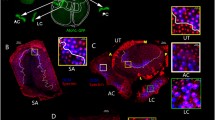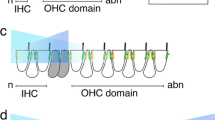Abstract
The morphological development of the vestibular maculae in the mouse was studied in order to identify elements that may determine how hair-bundle polarity is established. Utricles and saccules develop in parallel. Hair-bundles first appear at embryonic day (E) 13.5. They are initially not polarised and have a kinocilium located at the centre of the cell surface surrounded by stereocilia. Polarisation is rapidly established as the kinocilium becomes eccentrically positioned. The orientation of these polarised bundles is initially not random. It varies systematically across the maculae and the general orientation in utricles is the opposite of that in saccules. At E15.5, in both maculae, hair-bundle orientation angles fall into two populations that differ by approximately 180° defining a line of orientation reversal, the position of which varies little during subsequent maturation. Many more immature hair bundles appear at E15.5 suggesting a second wave of hair cell differentiation is initiated. Otoconial membrane is produced simultaneously across the entire width of both maculae, indicating directional growth of the overlying extracellular matrix is unlikely to influence hair-bundle orientation. Growth of both maculae occurs asymmetrically, essentially outwards from the striola, but it is most pronounced after orientation is defined. Microtubules are prominent in hair cells at the earliest stages of their differentiation, but are oriented parallel to the long axis of the cell and, thus, may not have a role in directing hair-bundle polarity. Microfilament assemblies that are aligned parallel to the apical surface and connect to the adherens junctions in supporting cells could provide a “framework” for hair-bundle orientation. The striated rootlets of ciliary centrioles that are aligned parallel to the cell surface with their tips associated with microfilament assemblies at adherens junctions were the only structural asymmetry identified that might influence the development of hair-bundle polarity.
Similar content being viewed by others
References
Bornens, M.(1991) Cell polarity: Intrinsically or extrinsically imposed? The New Biologist 3, 627–636.
Cotanche, D. A.& Corwin, J. T.(1991) Stereociliary bundles reorient during hair cell development and regeneration in the chick cochlea. Hearing Research 52, 379–402s.
Davies, S. J.& Forge, A.(1987) Preparation of the mammalian organ of Corti for scanning electron microscopy.Journal of Microscopy 147, 89–101.
Eaton, S.(1997) Planar polarization of Drosophilaand vertebrate epithelia. Current Opinion in Cell Biology 9, 860–866.
Eaton, S., Wepf, R.& Simons, K.(1996) Roles for rac1 and cdc42 in planar polarization and hair outgrowth in the wing of Drosophila. Journal of Cell Biology 135, 1277–1289.
Forge, A., Li, L.& Nevill, G.(1998) Hair cell recovery in the vestibular sensory epithelia of mature guinea pigs.Journal of Comparative Neurology 397, 69–88.
Goodyear, R.& Richardson, G. P.(1997) Pattern formation in the basilar papilla: Evidence for cell rearrangement. Journal of Neuroscience 17, 6289–6301.
Gumbiner, B. M.(1996) Cell adhesion: The molecular basis of tissue architecture and morphogenesis. Cell 84, 345–357.
Haddon, C.& Lewis, J.(1996) Early ear development in the embryo of the zebrafish, Danio rerio. Journal of Comparative Neurology 365, 113–128.
Hagiwara, H., Aoki, T., Ohwada, N.& Fujimoto, T.(1997) Development of striated rootlets during ciliogenesis in the human oviduct epithelium. Cell & Tissue Research 290, 39–42.
Hunter-duvar, I. M.& Hinojosa, R.(1984) Vestibule: Sensory epithelia. In Ultrastructural Atlas of the Inner Ear(edited by Friedmann, I.& Ballantyne, J.) pp 211–244. London: Butterworths.
Jerka-Dziadosz, M., Jenkins, L. M., Nelsen, E. M., Williams, N. E., Jaeckel-williams, R.& Frankel, J.(1995) Cellular polarity in ciliates: Persistence of global polarity in a disorganised mutant of Tetrahymena thermophilathat disrupts cytoskeletal organisation. Developmental Biology 169, 644–661.
Kaufmann, M. H.(1992) The Atlas of Mouse Development. London: Academic Press.
Lemullois, M., Klotz, C.& Sandoz, D.(1991) Evolutionary conservation of an epitope associated with striated rootlets in different epithelial ciliated cells. Biology of the Cell 71, 201–208.
Li, L.& Forge, A.(1997) Morphological evidence for supporting cell to hair cell conversion in the in the mammalian utricular macula. International Journal of Developmental Neuroscience 15, 433–446.
Mbiene J. P., Favre, D.& Sans, A.(1984) The pattern of ciliary development in fetal mouse vestibular receptors. A qualitative and quantitative SEM study. Anatomy & Embryology 170, 229–238.
Mclaren, A.& Buehr, M.(1990) Development of mouse germ cells in cultures of fetal gonads. Cell Differentiation & Development 31, 185–195.
Palmer, S. J.& Burgoyne, P. S.(1991) The Mus musculus domesticusTdy allele acts later than the Mus musculus musculusTdy allele: A basis for XY sex-reversal in C57Bl/6-YPOS mice. Development 113, 709–714.
Peraldi-Roux, S., Klotz, C., Nguyen-Thahndao, B.& Gabrion, J.(1991) A common epitope is shared by ciliary rootlets and cell-cell adherens junctions in ciliated ependymal cells. Journal of Cell Science 99, 297–306.
Ruben, R. J.(1967) Development of the inner ear of the mouse; a radioautographic study of terminal mitoses. Acta Otolaryngologica Suppl 220.
Stone, J. S., Leano, S. G., Baker, L. P.& Rubel, E. W.(1996) Hair cell differentiation in chick cochlear epithelium after aminoglycoside toxicity: In vivoand in vitroobservations. Journal of Neuroscience 16, 6157–6174.
Tilney, L. G., Cotanche, D. A.& Tilney, M. S.(1992a) Actin filaments, stereocilia and hair cells of the bird cochlea. VI. How the number and arrangement of stereocilia are determined. Development 116, 213–226.
Tilney, L. G., Tilney, M. S.& Derosier, D. J.(1992b) Actin filaments stereocilia and hair cells:Howcells count and measure. Annual Review of Cell Biology 8, 257–274.
Troutt, L. L., Van Heuman, W. R.& Pickles, J. O.(1994) The changing microtubule arrangements in developing hair cells of the chick cochlea. Hearing Research 81, 100–108.
Author information
Authors and Affiliations
Rights and permissions
About this article
Cite this article
Denman-Johnson, K., Forge, A. Establishment of hair bundle polarity and orientation in the developing vestibular system of the mouse. J Neurocytol 28, 821–835 (1999). https://doi.org/10.1023/A:1007061819934
Issue Date:
DOI: https://doi.org/10.1023/A:1007061819934




